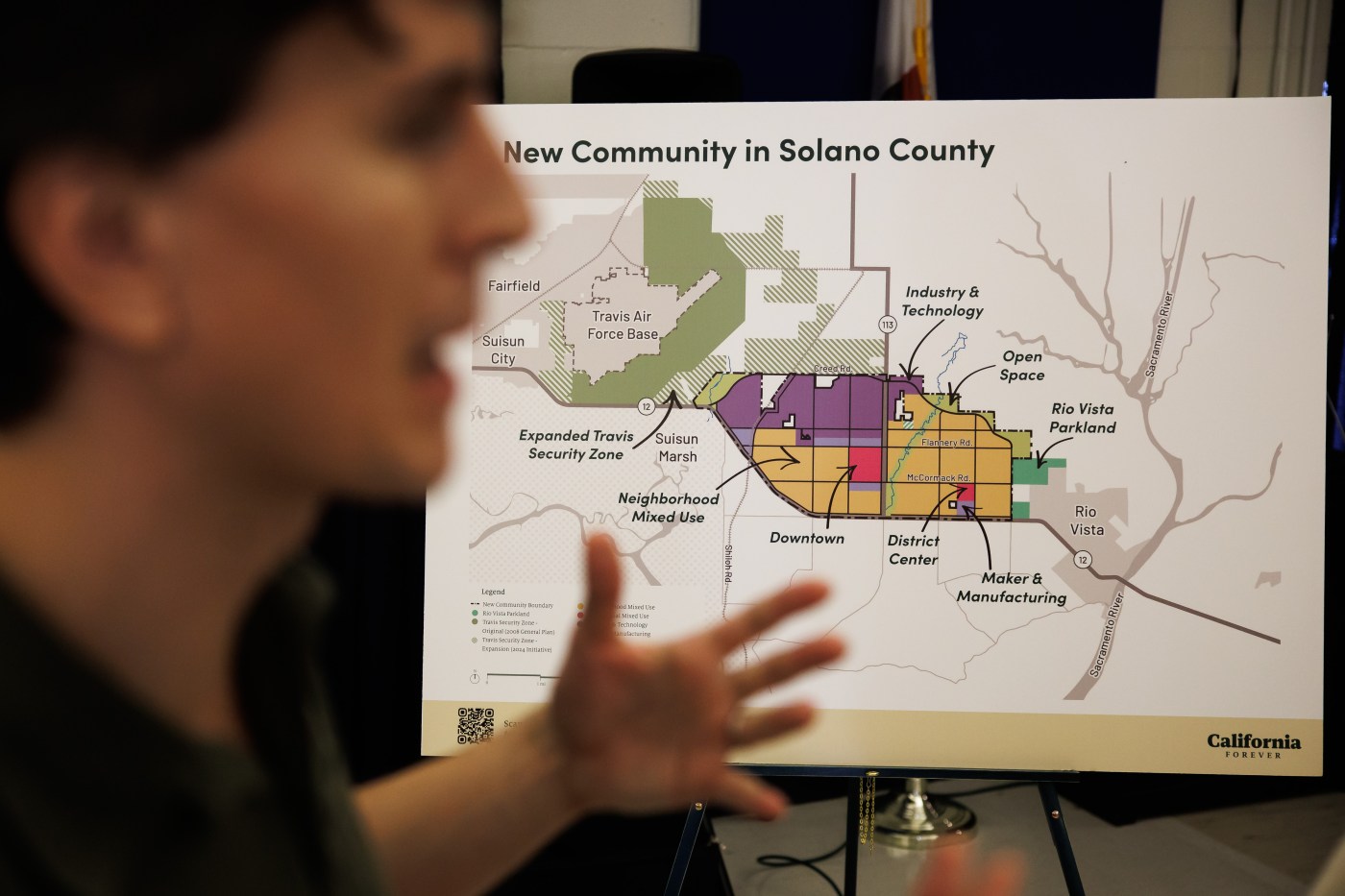Hundreds of thousands of residents. Thousands of well-paid jobs. Hundreds of millions of dollars in support for home purchases and low-income housing. Tens of millions of dollars in grants for education and training. Offices. Factories. Roads. Schools. Transit. Parks.
These are the promises from California Forever, the controversial company backed by Silicon Valley billionaires planning to build a new city from the ground up in Solano County. On Wednesday, the company revealed new details about the for-profit development and a proposed November ballot initiative to change the county’s general plan and zoning, which the project would require.
“Our proposal is for a walkable, medium-density, mixed-use community on 18,000 acres in eastern Solano County,” the company’s planning chief Gabriel Metcalf said at a news conference in Rio Vista near massive swaths of land the group has bought for the project. Metcalf is a former CEO at Bay Area civic-planning non-profit SPUR, the San Francisco Bay Area Planning and Urban Research Association.
California Forever aims to attract 400,000 people over the next several decades, making the city Solano County’s fourth-largest. For every 50,000 residents, California Forever said it would provide half a billion dollars in community benefits — $400 million for down-payment assistance to those buying homes or providing low-income housing, $70 million for scholarships, and $30 million for parks, open space, trails and support for agriculture.
CEO Jan Sramek said Wednesday that the investors, including billionaire venture capitalists Marc Andreessen and Michael Moritz and fellow billionaires LinkedIn co-founder Reid Hoffman and businesswoman Laurene Powell Jobs, “are people who believe in California,” and want to help make “actual life better for everyday Americans.” Sramek, 36, a former Wall Street trader, said he plans to move into the first home.
U.S. Rep. Mike Thompson, a Napa Democrat whose district includes the proposed new city, said he was not persuaded about California Forever’s commitment to the project after company representatives briefed him last week.
“They’re making promises, very generous promises,” Thompson told this news organization Wednesday. “They couldn’t tell me how these promises would be realized other than telling me, ‘Hey, we’re good people and we’re going to do it.’”
If voters support the initiative that would remove limitations on development in that area of the county, currently mostly agricultural, residents could come to regret it, Thompson believes. “Once those restrictions are lifted, they could sell the property to somebody else and walk away,” Thompson said. “It is extremely dangerous to reverse the hard-fought environmental protections that were placed on this property in exchange for a wink and a nod.”
The congressman said he also worries the promised community benefits might never materialize. “There’s no way you can make those kinds of guarantees,” Thompson said. “What if your project goes belly up?”
California Forever raised hackles in rural Solano County by keeping its plan secret while buying up tens of thousands of acres, then suing dozens of landowners in May for $510 million in damages over claims that through “endless greed” they conspired to jack up the sale prices of their properties.
Asked what assurance he could provide that the company and its backers would remain committed to the project, Sramek said California Forever had not taken on debt to fund the project, which has involved spending more than $800 million to buy land. “All of it is funded with long-term capital that’s here for decades to stay,” Sramek said. “We have the capability to withstand any recessions. We might slow down the construction, we might wait, but we are not going away.”
Profits from the California Forever project would come from selling and renting out land the company has bought, Sramek said. California Forever would be the master developer and construct some buildings, with many construction companies building out the rest, Sramek said. “We don’t want this to be a bland, cookie-cutter community where all of the houses look the same,” Sramek said. Residences would include small, self-contained units, apartments, and multi-story, single-family row houses, mixed together rather than being segregated as in many cities, Sramek said.
Questions around water supplies for a new city in California, where underground aquifers are severely depleted, have swirled around the project. Sramek said California Forever has secured access to water for at least the first 50,000 residents, and it would buy water as needed. “There are parties, particularly in Northern California, who are looking to sell water,” Sramek said. “We are already in discussions with several of them.”
California Forever said it would still be determined whether the “downpayment assistance” in the $400 million “Solano Homes for All” program described in the initiative would be grants or loans.
The proposed initiative also includes a “guarantee” to provide 15,000 jobs that pay at least 125% of the prevailing average wage, which varies by job, in the county. Under the initiative, missing that target would mean the city could not grow beyond 50,000 residents.
Anyé Spivey, California Forever’s director of development planning, highlighted the proposed initiative’s Taxpayer Guarantee that would shield Solano County residents from costs in the new community, including to build schools and infrastructure. “The new community has to pay its own way for both infrastructure and services,” Spivey said. “Everything that we need has to be paid for by the residents and employers in the new community, and not by anyone who resides outside of it.”
Sramek has said the plan could go ahead even without county residents approving the initiative. On Wednesday, he added that the project could be built without voter approval in “small increments.” However, he said, “If we can plan the entire community and if we can plan it once, approve it once, that’s what allows us to provide all of these amazing community benefits and that’s what allows us to bring large employers.”













+ There are no comments
Add yours